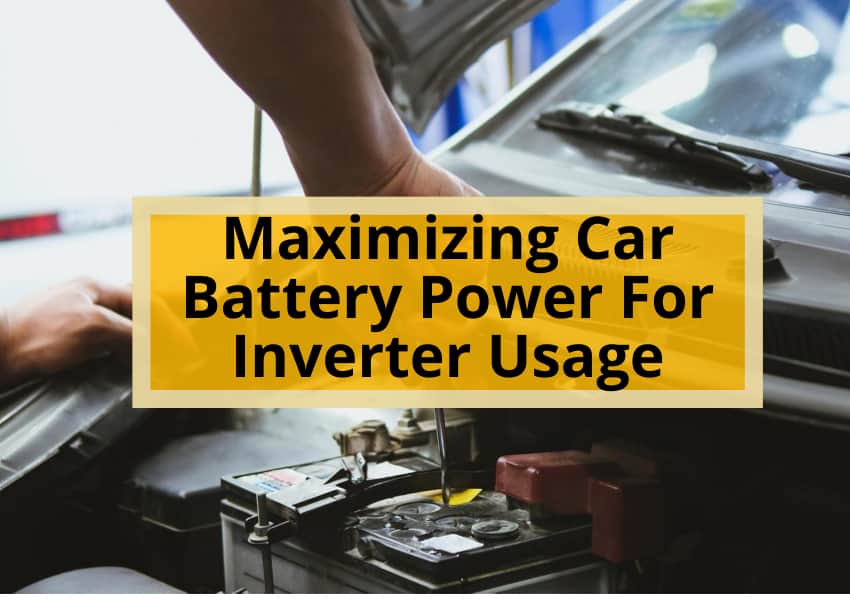In today’s fast-paced world, where constant connectivity is paramount, the need for reliable and efficient power sources is more crucial than ever. Whether you are on a road trip, camping in the wilderness, or simply experiencing a power outage, having a car battery-powered inverter can be a lifesaver. However, maximizing the potential of your car battery for inverter usage requires careful consideration of key factors. This article aims to explore these factors and provide insights into how to optimize your car battery’s power effectively.
Firstly, we will delve into the importance of efficiency when it comes to the inverter. Efficiency is not only crucial in determining the duration of the battery but also influences its overall performance. We will discuss how to calculate the appropriate battery size based on the inverter’s efficiency and maximum load capacity.
Furthermore, we will explore the impact of battery life and consumption on the duration of inverter usage. Factors such as power capacity and demand significantly affect how quickly the battery drains. By understanding these dynamics, you can make informed decisions about your power consumption and prolong the battery’s life.
Lastly, we will outline essential safety precautions and tips to ensure a smooth and secure experience when using a car battery for inverter applications. By following these guidelines, you can safeguard both yourself and your equipment.
In conclusion, this article aims to equip you with the knowledge and understanding of key factors that can maximize your car battery’s power for inverter usage. By considering efficiency, calculating battery size, managing power consumption, and adhering to safety precautions, you can enjoy extended and uninterrupted power supply wherever you go.
Factors affecting duration
Factors affecting the duration of car battery power for inverter usage include battery capacity, type, and efficiency of the inverter. Battery voltage drops as it discharges, leading to increased current draw by the inverter to maintain output voltage. The battery capacity and type play a crucial role in determining how long the battery can power the inverter. A higher capacity battery will provide longer runtime compared to a lower capacity one.
Additionally, the efficiency of the inverter is more important than its maximum load capacity. The more efficient the inverter, the less power it will consume from the battery, resulting in a longer duration of use. It is important to note that as the battery discharges, its voltage drops, which causes the inverter to draw more current to maintain the desired output voltage.
Therefore, understanding these factors is crucial in maximizing the duration of car battery power for inverter usage.
Efficiency of the inverter
Efficiency is a critical aspect to consider when evaluating the performance of an inverter, as it ironically determines the extent to which the car battery’s power can be effectively utilized. In simple terms, efficiency refers to the ability of the inverter to convert the DC power from the battery into AC power without significant losses. A higher efficiency means that more of the battery’s power is being converted into usable electricity, resulting in longer battery runtime.
To illustrate the importance of efficiency, let’s consider a comparison table showcasing the impact of different efficiency levels on battery duration:
| Efficiency Level | Battery Duration |
|---|---|
| 80% | 4 hours |
| 90% | 5 hours and 42 minutes |
| 95% | 6 hours and 19 minutes |
As seen in the table, even a small increase in efficiency can significantly extend the battery’s runtime. Therefore, it is crucial to choose an inverter with a high efficiency rating to maximize the utilization of the car battery’s power. By doing so, users can enjoy longer periods of power supply, ensuring their needs are met for an extended period of time.

Calculating battery size
When determining the appropriate battery size for a given load, it is important to calculate the required capacity by multiplying the required hours of power by the load in watts and dividing by the voltage of the DC system.
This calculation allows users to estimate the amount of battery capacity needed to power the inverter for a specific duration. For example, if a 3000W 12V inverter needs to be powered for 1.5 hours, a battery with a capacity of approximately 250 DC amps/hour would be required.
Understanding this calculation is crucial in ensuring that the battery can provide enough power to meet the demands of the inverter. By considering the required hours of power, the load in watts, and the voltage of the DC system, users can determine the appropriate battery size to maximize the power output of their inverter.
also read : Optimizing Power Supply: Alternator, Inverter, And Battery Connection Guide
Battery life and consumption
Battery life and consumption are important aspects to consider when using an inverter to power electrical devices. The duration for which a car battery can power an inverter depends on its power capacity and the amount of energy consumed by the connected devices. Higher demand leads to faster battery drain.
It is crucial to understand the battery’s power capacity and consumption rate to determine its runtime accurately. Recharging the battery is necessary once it gets discharged, which can be achieved by running the engine or using a solar charger.
Safety precautions should also be followed, such as keeping the inverter in a safe location, away from liquids and heat sources, and ensuring proper ventilation. By considering these factors and making efficient use of the inverter, one can maximize the battery’s power and extend its lifespan.
Safety precautions and tips
To ensure the safe operation and longevity of your electrical equipment, it is essential to adhere to a set of precautionary measures and guidelines. These safety precautions and tips will help maximize the car battery power for inverter usage:
- Placement: Keep the inverter on a stable, vertical or horizontal surface to prevent accidental tipping or damage.
- Installation: Avoid installing the inverter in the engine chamber or any area exposed to liquids or rain to prevent potential hazards.
- Dry Environment: Ensure that your hands and feet are dry when operating the inverter to minimize the risk of electrical shock.
- Ventilation: Provide proper ventilation to prevent overheating. Keep the inverter away from heat sources, such as direct sunlight or hot surfaces.
Following these safety precautions will not only protect you and your equipment from harm but also contribute to the overall efficiency and longevity of your car battery and inverter system.
Frequently Asked Questions
Can I use any type of car battery to power an inverter, or are there specific types that work best?
Specific types of car batteries are recommended for powering inverters. Deep cycle batteries are ideal due to their ability to handle repeated discharging and recharging. Engine start batteries should be avoided for this purpose.
Is it better to have a higher capacity battery or a higher efficiency inverter for longer power duration?
A higher capacity battery is generally better for longer power duration because it can store more energy. However, a higher efficiency inverter can also contribute to longer power duration by converting more of the stored energy into usable power.
Are there any specific maintenance tips for prolonging the life of a car battery used to power an inverter?
To prolong the life of a car battery used to power an inverter, it is important to regularly recharge the battery by running the engine or using a solar charger. Additionally, proper installation, maintenance, and safety precautions should be followed to ensure optimal battery performance.
How does the temperature affect the performance and lifespan of a car battery used with an inverter?
Temperature can significantly affect the performance and lifespan of a car battery used with an inverter. Extreme temperatures, both hot and cold, can reduce the battery’s capacity and increase self-discharge, leading to decreased battery life and overall efficiency.
What are some common mistakes to avoid when using a car battery to power an inverter?
To avoid common mistakes when using a car battery to power an inverter, it is crucial to consider factors such as battery capacity, efficiency, and proper installation. By understanding these factors, one can maximize battery duration and ensure safe and effective usage.






